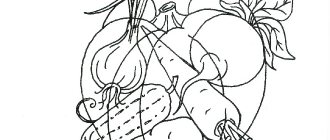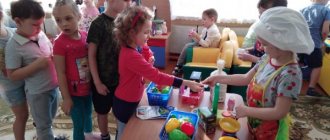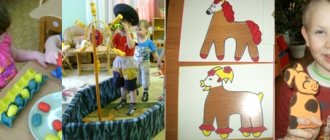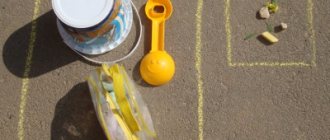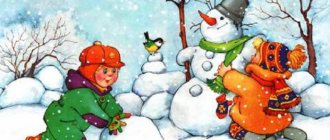1. Learn the concept of “many - little”.
2. Closer to three years - master the concept of “more-less” (determine the number of objects in a group - which ones are more and which ones are smaller).
3. Learn to distinguish between the number of objects “one” and “two”. (At a minimum. You can go further, learn to count to 3 - 4, but not all children aged 2 to 3 can do this - take into account the child’s interest and his abilities).
4.Learn to sort objects - by size, by color, by type (sort different types of pasta, buttons, large and small objects (circles, squares, etc.)), try other types of sorting.
5. Learn to navigate in space (learn the concepts of higher, lower, right, left).
6. Fold yourself, without the help of your mother, elementary puzzles or cut-out pictures from 2-3-4 parts (this skill develops gradually and becomes more developed closer to three years; at first, the mother helps the child).
7. Learn to match - play “who eats what”, “where is whose house”, “where is whose tail” (with cards or in pictures in books and manuals).
8. Play riddles - the mother describes an object or animal in the simplest form, the child guesses it from the description (for example - small, fluffy, with long white ears, jumps like that and eats carrots, who is it? Who says “moo-moo” and gives milk? Etc. Gradually you can complicate the riddles).
9. Guess the animal from the description.
10. Stack several nesting dolls and cups into each other.
11. Build a tower from cubes/cups with decreasing size values
12. Learn to compare figures, geometric bodies with their projections (Dyenesha blocks, homemade preparations)
13. Closer to three years - designing simple structures according to drawings
14. Starting from 2.5 years old - play “Fold the Square” by Nikitin (at first - together with the child, but very quickly children learn to assemble it on their own)
15. Starting from 2.5 years old – play with prefabricated puzzles
16. Learn to classify objects according to a general characteristic (for example: cards with pictures of toys, food, animals are laid out in front of the child. The child is asked to arrange them into appropriate groups (for example, toys in a box, food in a “refrigerator”, animals in a “house”). At first, the child learns to arrange objects with the active help of his mother.For the learning to be successful, it is better to play for a long time with the same set of objects (for example, to begin with, for a long time sorting cards of only toys and food).
Cards or wooden “Pick a Group” toys are great for mastering this skill:
17. Classification of objects - play the game “what’s in this room?” (find what is round in this room? What is soft in this room, etc.).
18. Games with Dienesh blocks, with a simple construction set, and other suitable items (toys, pasta, buttons, beads, etc.) by type:
– find objects, figures of the same shape;
– find objects, figures of the same color;
– find objects, figures of the same size;
– find the same figures by size, thickness and other characteristics.
19. Games with Cuisenaire sticks.
20. Play “part and whole” – “whose tail is this”, “match the roof to the house”, etc.
21. Learn to find a figure based on two signs (for example, find a large yellow circle (in a group of objects there is also a small yellow circle and circles of other colors), a small red square, etc.).
22. Closer to three years (and very individually) - find mistakes in pictures (working with manuals) - what is missing, what is wrong, which of the objects is the wrong color, etc. The very inexpensive manuals from the “Smart Books” series are great for this:
Studying the properties of objects.
1. Colors of objects.
2. Geometric figures, shapes. 3. Long-short. 4. High - low. 5. Wide-narrow. 6. Same and different (closer to three years). 7. Warm-cold. 8. Hard-soft. 9. Smooth-rough. 10. Heavy-light. 11. Taste, smell. Development of attention.
1. Play “Find it!” – we ask the child to find an object in the room (find where your teddy bear is, where the red cube is), on the street (look through the window - find where the dog is walking? Find the red car!), search in a picture in a book, etc. .P. – you can play anytime, anywhere. This game is very simple, children are easily drawn into it. At the same time, attention and the ability to concentrate it develop very well.
2. The game “Find a Pair” is a more complicated version than it was for a year or two - find a pair among objects that are very similar to each other.
3. Find the same pattern (pairs of mittens, hats, cups and saucers, patches for towels, roofs for houses, etc.)
5. Games with Dienesh blocks, Cuisenaire sticks.
6. Search for objects based on one characteristic - find what is red, hard, soft, round, large, etc. in this room. (you can play anywhere).
7. Search for objects based on two characteristics - find what is large and white, small and hard, etc. in this room.
8. Play hide and seek with the child (hide so that the baby can easily find it, prompt the child by calling him with your voice). How to develop memory.
1. “What’s missing?” - remember the pictures (toys) laid out on the table, guess which picture mom hid. Memorizing objects is carried out in a playful way - the mother tells a fairy tale about objects that are laid out on the table; during the process of the fairy tale, the child manages to remember its characters well. After this, mom takes one of them and asks “who is missing?” You can read more about how to play this game with very young children here.
2. What appeared? – we play according to the same principle as written in the previous paragraph, but we do not hide, but add toys, the child must determine which toy the mother added.
3. Hide 3-4 toys with the child. Then ask him to find them (we search from memory).
4. Ask the child to bring 2-3 items (we bring items from memory).
5. Together with the mother, remember what the child did yesterday, in the morning, some time ago, what events happened on the street (which friends were out today, what toys they had, etc.).
6. Remember what is drawn in the picture and answer questions about what was drawn there after the picture is closed.
7. Game “Find a Pair” with hide and seek – the mother shows the child a picture and hides it behind her back. Asks to find the same picture in a group of cards (the child looks for a paired picture without holding it in his hand, as usual, but from memory)
8. Game of “thimbles”. We take multi-colored cups and put a toy under one of them. We swap the cups several times, then ask them to find where the toy is hidden (we gradually increase the number of toys and cups).
9. “Memory” – a game with 2-3 cards. We put cards in front of the child, the child remembers them (to help him, you can tell a fairy tale about the heroes who are drawn in the pictures; while listening to the fairy tale, the child will remember the location of the cards well. The “fairy tale” can be very simple from 4-5 sentences). We turn the cards picture side down - this way, all the pictures are hidden from the baby and are not visible to him. We ask the child to find where a certain card is located from memory (“find which card has a bear on it?”). Another version of “Memory” can be found here. Physical development.
1. Jump in place on two legs. Closer to three years - learn to jump forward (but not everyone succeeds in this).
2. Learn to throw and catch a ball, throw a ball against a wall.
3. Throw up a balloon or ball.
4. Maintain balance while walking along a board placed on the floor, along a bench, or a beam.
5. Depict animal movements as shown by mother.
6. Crawl (like a boa constrictor, like a caterpillar) on your stomach forward.
7. Jump like a bunny.
8. Pretend to be a bird - wave your arms while running around the room, squat - “look for grains in the grass”, jump - “fly up”.
9. Stomp loudly, raising your legs high, like an elephant.
10. Swim like an octopus: lie on your back, raise your arms and legs up, wave your arms and legs (“swim”).
11. Run fast, slow, on your toes.
12. Sitting on the floor, knock on the floor with your feet, “like a drum.”
13. Roll on the floor like a bun.
14. Jump from a half-squat like a frog.
15. Dance and practice logorhythmics (to the music of the Zheleznovs and other authors).
16. Lift objects from the floor by bending or squatting.
17. Reach your arms up, reaching for objects that are located high (the mother can hold objects at the height of the child’s outstretched arm).
18. Move around the room without touching objects scattered on the floor (for example, pillows), gradually increasing the pace and number of objects.
19. Carry large, but not heavy things (for example, a highchair, a light box of toys).
20. Walking on massage surfaces.
21. Walking on tiptoes, closer to three years - on heels.
22. Perform dance movements - place the foot on the toe, on the heel.
23. Walking along a winding line drawn on the floor (or a strip of paper) - development of coordination.
24. Crawling under a tight rope.
25. Game “Catch a sunny bunny” - we play with a sunny bunny that mom lets out.
26. Collective games: dance in a circle, run like a train after each other (children hold on to each other), games with a special children’s play parachute, games of “catch up”, “wolf and bunnies”, etc.
27. "Cat and mouse." While the cat is sleeping (an imaginary cat or another adult), the children and mother walk quietly. When the cat wakes up, they quickly run into the house.
28. Hanging on the horizontal bar, rings, mother’s hands.
29. Climb on sports walls at home, on playgrounds.
30. Walking on “bumps” (chaotically scattered pillows, books).
31. Climb through a tunnel (purchased or built from chairs placed in a row).
32. Fitball games.
33. Game “Snail and House”. The child gets on all fours. A pillow is placed on his back. He turns into a snail, which carries its house (pad) on its back. The snail's task is to walk as long as possible without dropping its house (we crawl on all fours, carrying a pillow on our back).
34. Walking on your hands
Music and rhythm.
1. Listen to a lot of songs according to age.
2. Learn to listen to music - listening to classical melodies with your mother, listening to your mother’s story “What does this melody tell us?” It’s easy to come up with such a story yourself (for example, like this), with its help the child develops the ability to truly listen to music, to capture its shades and mood.
3. Learn to distinguish between fast and slow music, learn to play noise musical instruments quickly and slowly.
4. Learn to distinguish between happy and sad music.
5. Learn to distinguish between loud and quiet music, learn to play noise musical instruments loudly and quietly.
6. If there is an opportunity (large family) to play the game “who called?” (the child guesses by voice who is calling him).
7. Listen with your mother to the “sounds of life” - birds chirping, a car making noise, leaves rustling, etc.
8. Try to determine where the sound is coming from (for example, “do you hear a bird chirping? What tree do you think it’s sitting on?”).
9. Practice logorhythmics (to the music of the Zheleznovs and other authors).
10. Play musical instruments (children's and noise instruments - drum, maracas, tambourine, xylophone, etc.).
11. Get acquainted with various instruments and their sounds (you can watch videos on YouTube with your child, where performers play classical music on various instruments).
12. Closer to three years (if the child is fond of songs and remembers many melodies by ear) - play guess the melody - the mother sings the melody (“A Christmas tree was born in the forest”, “Antoshka”), the baby guesses what kind of song it is.
13. Sing songs to your child.
14. Dancing - fast, slow, stamping your feet, clapping your hands, twirling your palms - the "flashlight" movement, jumping, putting your feet on your toes - on your heels when dancing, tapping your heel on the floor, tapping your toes on the floor, doing a round dance, dancing with objects – spoons (we dance and knock spoons on the floor, against each other, over our heads, behind our backs, loudly-quietly, quickly slowly), maracas rattles (we dance and accompany ourselves, perform the same movements as with spoons), with handkerchiefs ( alone and in pairs with mom.)
15. Encourage independent performance of dance movements to dance tunes. Intensify the performance of movements accompanied by music that convey the character of the animals depicted. Drawing.
1. Draw paths.
2. Draw circles
3. Draw simple compositions - rain, snow, grass, Christmas tree decorations on the tree, circles (which will be balls, apples, etc.), draw sticks - strings for balls, stems (sticks) for flowers, handles for shoulder blades, hedgehog needles, grass, patterns (random) on cups, rugs, towels.
4. Draw vertical and horizontal lines.
5. Draw short and long lines.
6. Closer to three years - color pictures (some drawing teachers are against coloring - they believe that coloring kills creativity (since the child does not draw on his own, but works according to a ready-made template). Decide individually whether to teach your child to color or not).
7. Draw the child’s attention to the choice of color for the drawing (we draw the grass in green, the rays of the sun in yellow).
8. Draw with a stick on sand, semolina, snow.
9. Leave prints with paints using stamps and sponges.
10. Learn to paint with paints (wash and wet the brush).
11. Paint with finger paints. Modeling.
1. Roll out plasticine and dough with straight and circular movements of your hands (balls and sausages).
2. Break off small lumps from a large lump, flatten them with your palms and fingers.
3. Connect the ends of the rolled stick, pressing them tightly against each other.
4. Just play with dough and plasticine (free creativity).
5. Sculpt lumps of plasticine onto paper (feed the chicken, make dots for the ladybug, etc.).
6. Master the technique of smearing plasticine on paper.
7. Leave imprints on the dough with various objects.
8. Cut out shapes from the dough using cookie cutters.
9. Learn to cut dough with a plastic knife. Application.
1. Make a plot applique (sun + cloud + house, etc.) from 2-3 objects.
2. Apply an object of 2-3 parts (houses (roof + window), mushrooms (hat + leg), etc.).
3. Applique made of cotton wool (depict clouds, snow, dandelions, sheep, etc.).
4.Applique made from crumpled up lumps of paper.
5. Applique made from torn paper. Construction.
Build houses, fences, bridges, a slide, a garage. Play with Lego. Closer to three years - build houses according to a simple drawing (from two or three parts). Games with Dienesh blocks. Games with Cuisenaire sticks.
The world.
1. Continue studying domestic and wild animals and their young. Learn simple facts about animals (where they live, what they eat, characteristic features, for example, “a cow gives milk”, “a goat butts”, etc.), learn what domestic animals give to a person, learn the names of the main parts of an animal’s body (horns) , hooves, etc.).
2. Birds - expand your knowledge about bird species, study basic facts about birds (where they live, what they eat, how offspring appear, names of chicks). Get acquainted with the division into domestic and wild birds (simply talk about this with the child, when studying birds, emphasize that someone lives next to a person and benefits him, someone is a wild bird and lives on its own).
3. Insects – study the most common insects (ant, bee, butterfly, etc.); know the simplest facts from their life (a bee brings honey, a caterpillar gnaws on leaves, etc.), recognize them by their appearance, and cultivate a kind attitude towards insects.
Hearing development
Montesosri pedagogy uses noise cylinders and bells. Continue offering your child a variety of musical toys. Now these can be more complex instruments: drums, xylophone, various bells. Play instruments and sing with your child. Encourage your baby to listen to melodic music.
Show your child how to concentrate attention on any one property of an object, isolating other senses. Gradually teach your child to work with his eyes closed. Seeing how you close your eyes, smelling a tangerine, tasting the first bite of food or touching a fabric, he will gradually learn to do the same himself.
Mini-courses for parents
Expert recommendations and analyzes of real situations
To learn more
The principle of constructing classes for preschoolers
All classes for preschool children are based on the principle of playful learning and development. Children better assimilate information that is presented to them unobtrusively, in the form of a game.
Classes should be conducted after a night or daytime sleep - this is the very time when the preschooler is ready to learn new material. The duration of classes should not exceed 25 minutes.
For classes, you need to prepare props, make a plan and think through a scenario. It is better if all the exercises in one lesson are united by a common plot. This could be a certain fairy-tale hero who comes to visit the baby and needs help. The latter helps the guest solve problems and find a way out of the situation, simultaneously learning the material and the necessary knowledge.
My new activity program for a 3 year old (with template)
I have once again reviewed the lesson plan with my daughter and want to share an example and template with you. Perhaps this will help someone create their own program. You can download it here, and explanations of what it is and how it was compiled are below.
Why was I not satisfied with the previous “fruit of methodological quests” - checklists for different ages? I still like it, and I distribute it to my subscribers with comments and recommendations for filling it out here.
However, for a number of reasons I wanted to try something new. And these reasons are as follows.
Firstly, I began to notice that I was giving out many items from my checklists automatically, without any accounting or planning. The necessary questions and tasks on such basic topics as comparisons, counting, colors, shapes and the like, which can be thought up for any game and any plot, are invented by themselves. I wrote about how to touch on several topics at once when telling a fairy tale here.
Secondly, my daughter’s age is approaching 3 years, her opportunities and “witness” are increasing. Interests also change. Previously, I practically ignored classes on topics , themed weeks, because I didn’t see my daughter’s desire to study for a long time on any one topic (seasons, our home, fruits and vegetables, and the like). Or maybe she didn’t want to delve into one subject for too long.
Now, holding in my head various disturbing thoughts for mothers like “after three it’s too late” and watching my daughter, for some reason I wanted to try to study on the topics, to expand my daughter’s ideas about the world “in depth.” Therefore, the level of her knowledge, vocabulary and the same “thinking” - everything that we have been doing in the last year - now suits me completely.
Actually, the new template plan for daily and weekly classes is an attempt to combine planning in areas of development (speech, logic, sensory, etc.) and thematic planning. And also “sew” cheat sheets here , which I have already advertised more than once as a very useful tool for mothers. For example, here.
This is what happened. When creating your own training program, two points are important:
1) Contents. What will we develop, in what areas, where to get the material, and so on.
2) Structure. How to arrange all this so that it is convenient to use.
Let's start with the content.
In general, I have moderated my appetites: my daughter goes to home kindergarten for half a day, where she is also taught quite closely, plus there should also be time for independent play. Therefore, in my plans I left 4 areas for daily and weekly classes, as well as several rituals and traditions that I would like to develop .
The daily routine turned out like this: speech development and physical development (this goes without saying), plus the “Nature” cycle (meaning observation of the weather, experiments with natural materials, emphasis on the environment, the nature of our country - African and other the daughter has already “been ill” with exotic animals), as well as social and everyday development . Here I included my favorite role-playing games with practicing the rules of behavior in society, emotional development and everything related to the life and relationships of people.
The rituals included something that we still sometimes forget to do: listen to music (dynamically, with dancing and “just listening”), discuss the results of the day. The rest is innovation. I decided to experiment on myself and my daughter and try a set of ready-made classes. The one I came across very organically fit into my desires to observe nature and begin to introduce my child to the achievements of culture. Previously, I used other people’s developments only partially: I took presentations or individual games. Then I’ll be sure to tell you what happened.
The weekly plan included the following 4 points:
Creation. We can’t manage to create every day; my daughter now has other interests. And if from time to time - with pleasure. Therefore - in the weekly plan.
Mathematics and logic , as well as general development. In the background, these directions “slip” every day for us, and giving assignments on albums, special games every day seemed tiresome for me and for the child.
Natural cycle. The name is not childish, but it was necessary to somehow designate all this: the basics of geographical concepts (about our planet, about the relief, continents and oceans, weather), animals and plants of various parts of the world, the simplest physical experiments and the first ideas about such general concepts as air, water, earth, etc.
Humanitarian cycle. Here I included stories about history and games based on them, acquaintance with works of art, with the life and traditions of the peoples of the world. With cultural heritage, in a word. Would you say it's early? Read Cecile Lupan.
Why are there 4 spheres when there are 7 days in a week, or 5 - without days off? Firstly, because I simply couldn’t think of other priorities, and secondly, some things could be repeated, and particularly interesting topics could be stretched out over two days.
In the fifth block, I included a list of all the teaching aids and “basic toys” that we have in service. So as not to forget about them. It happens to us that we don’t remember about some very useful toy for several weeks.
Once the content has been decided, the question arises of how to arrange it all.
In checklists, I like the idea of putting marks on completion. This includes self-control, introspection, encouragement, and much more. Therefore, I left a column with marks for 2 weeks (14 cells). Moreover, looking ahead, I will say that at the time of inventing and publishing the article we were visiting, the tools I had were paper, a pen, a red marker and transparent tape (and no printer), so during the process of manual assembly I came up with this idea: if the cells Once completed, seal it with a strip of transparent tape and put marks on it with a marker or felt-tip pen, the plan becomes reusable: all these marks can be easily erased and started filling out again. This version is a “very rough draft”: I wanted to do it quickly, but I only had half an hour to spare.
Both the daily and weekly sheet are divided into 5 parts (4 selected spheres + 1). A pocket is glued under the heading; cards with ideas for what to do in this area this week should go there. For example, if we found an interesting finger game, we immediately wrote it down on a small piece of paper and put it in the right pocket. And on the pockets themselves there is a list of, let’s say, types of activities. In the checklists these were sub-items in each of the areas. For example, “Physical development”: exercises, fitball, ball games, sports complex, etc. And in my pocket there are specific games - with a ball, fitball, new rhymes for exercise. Used cards can be collected in a game library. For example, in an organizer with transparent files. Since the cards are small, A5 format or a 10x15 photo album with transparent pockets will be convenient.
As I already wrote, the daily plan includes a list of rituals/routines as a bonus, also with marks of completion, because... this is essentially the most important list for implementation, and with a pocket for ideas. For example, we have a slight problem - the child has stopped loving swimming. The topic of games in the bathroom has become relevant. I am actively collecting ideas.
In the weekly plan, block 5 is a list of aids and toys, with a pocket for ideas on how else to use them or what aids to make/buy.
This system was born, as always, overnight. Let me clarify again, it was for a child of approximately 3 years of age . It should also be suitable for older children, but for younger children – just take the idea of design and organization of the material.
The template is in doc format, that is, fully editable, download from the link. I didn’t decorate it with anything: a normal work plan. I would be glad to receive feedback and comments on how convenient it is to use (if you decide to use it).
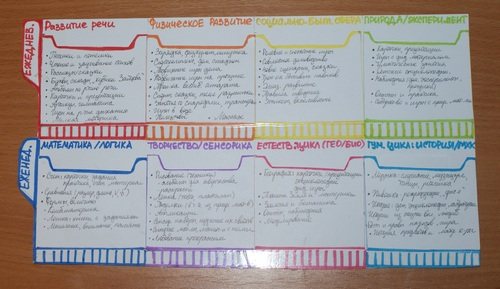
And here is a compact version of the same plan. First of all, it’s prettier)). Secondly, two A4 sheets did not physically fit into my “home office” on the refrigerator, which I was very used to. You can see what else is included here and here. I had to hang these sheets very low, and my daughter kept bringing them to me: “Mom, these are yours.”
Thirdly, there has suddenly been a tendency towards “do-it-yourself” rather than computer-made versions. I noticed that when you write with your hands, it is better remembered in your head, and such plans, in fact, are needed so that they fit better and are implemented faster.
Here, it was not by chance that I specially taped the strip for marks on completion with thin tape, making the plan reusable: marks with a marker are easily erased after 2 weeks. The “list of benefits” block was dropped due to inconvenience: after working a little with the draft version of the plan, I “remembered” about them and began to get them more often. And the “rituals” moved to a separate sheet, in conjunction with my personal list of useful habits to implement.
Now the “control panel” of the house in its final (hardly) form looks like this:
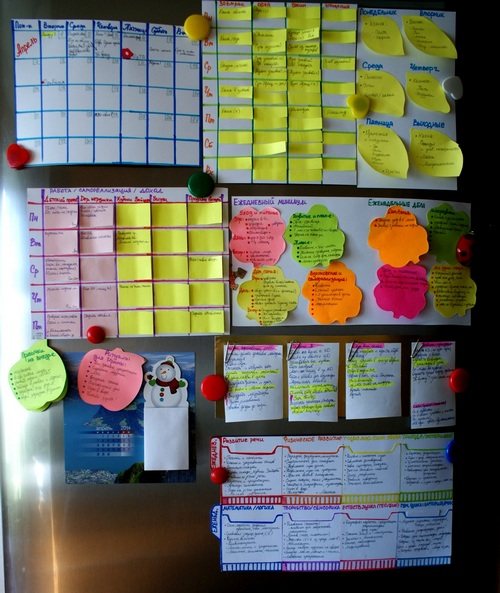
I don’t encourage anyone to follow exactly my path, everyone has their own. For example, history, geography and MHC for kids are my personal obsession. Nevertheless, I hope that my explanations of why and how will help someone choose what is important and necessary.
